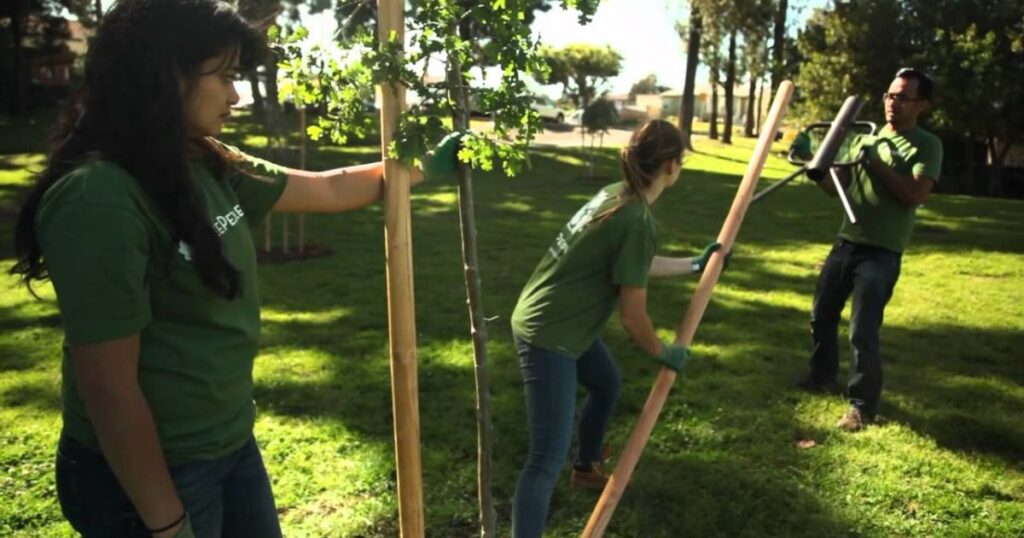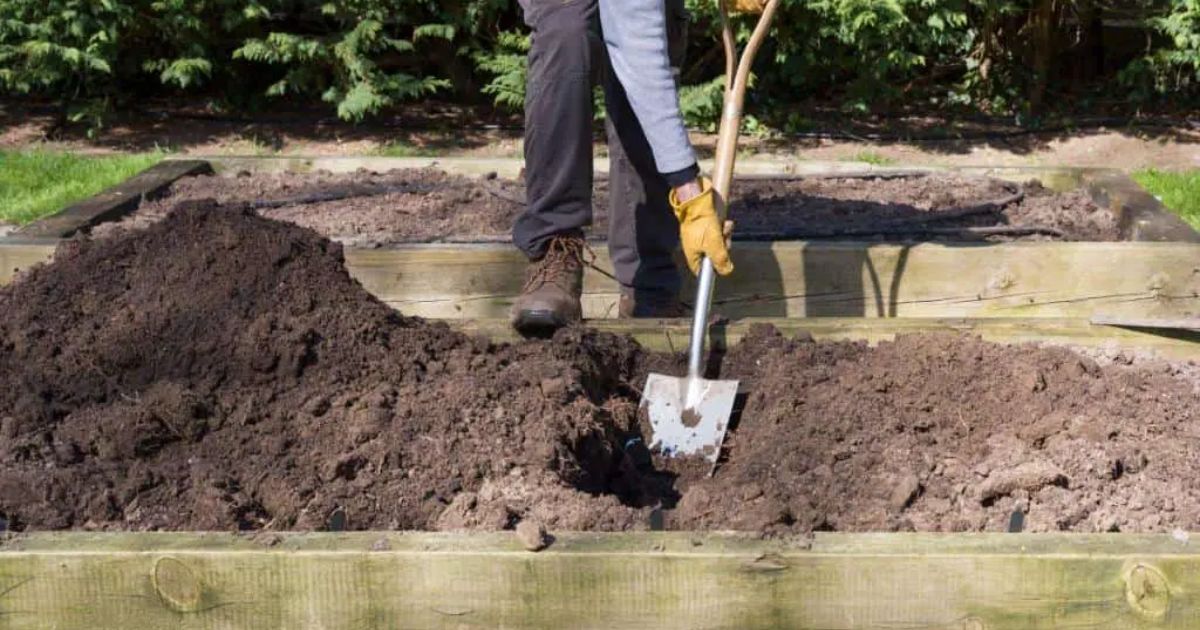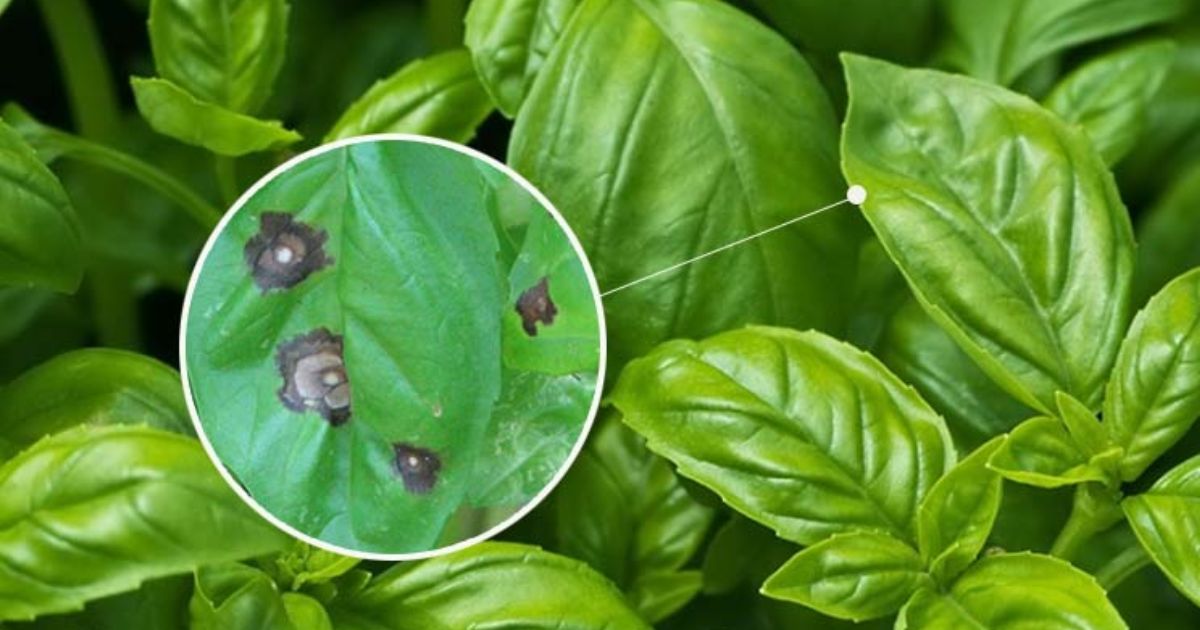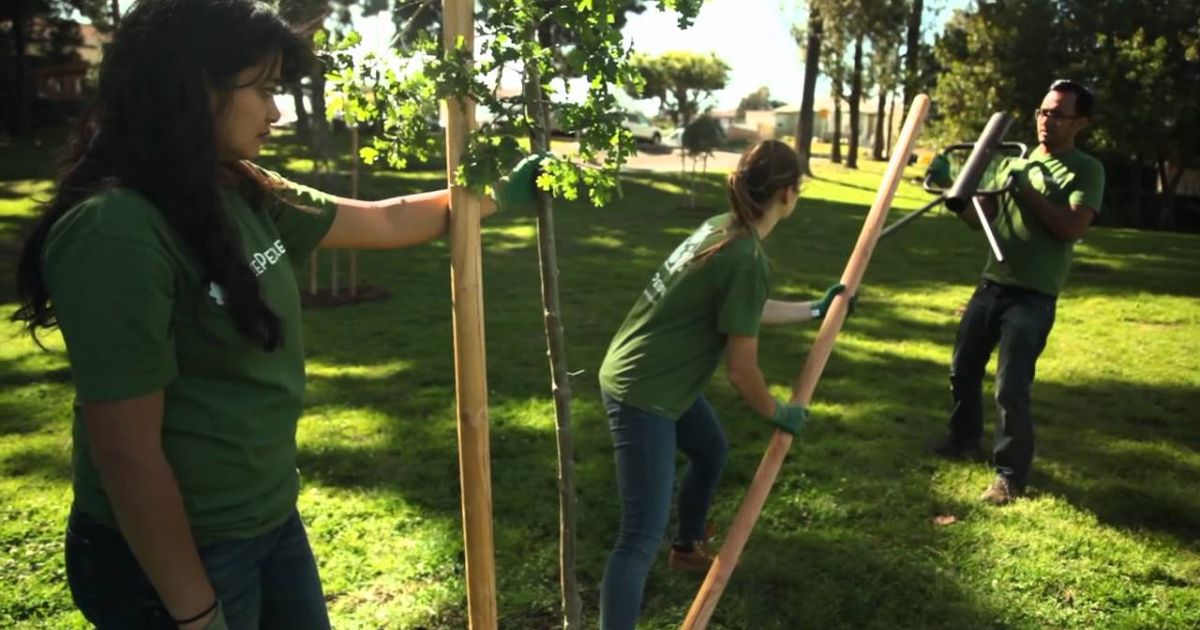In addition to being unsightly, a leaning tree in your garden may be a sign of an unstable or suffering tree that, if neglected, may experience long-term health issues. There are several reasons trees may tilt, including strong winds, uneven soil, shallow roots, or improper planting. Correcting a leaning tree early is crucial, especially for young or newly planted trees, because it helps them develop a strong, straight trunk and a healthy root system.
Staking is one of the most effective methods for supporting a leaning tree and guiding its growth upright. However, staking must be done carefully to avoid damaging the tree while still providing sufficient support. In this guide, we’ll walk you through why trees lean, when staking is necessary, the tools you’ll need, and step-by-step instructions to safely stake your tree for a long and healthy life.
Why Trees Lean
Trees don’t always grow perfectly straight, and a leaning tree can be a sign of underlying issues. Understanding the reasons why trees lean can help you determine the best way to support them.
Wind and Weather: Strong winds, storms, or heavy snow can push a young or newly planted tree to one side. Over time, repeated exposure can cause the tree to grow at an angle.
Poor Soil Conditions: Trees planted in loose, sandy, or waterlogged soil may struggle to anchor their roots firmly. Shallow or uneven root systems make the tree more susceptible to leaning.
Root Damage or Weakness: If a tree’s roots are damaged during planting, How to Plant Trees: A Comprehensive Step-by-Step Guide construction, or due to pests and disease, the tree may not have a stable foundation. This can lead to leaning, especially after rain or wind.
Improper Planting: Planting a tree too deep, too shallow, or on a slope can cause it to grow unevenly. Young trees are especially vulnerable to leaning if they are not planted correctly.
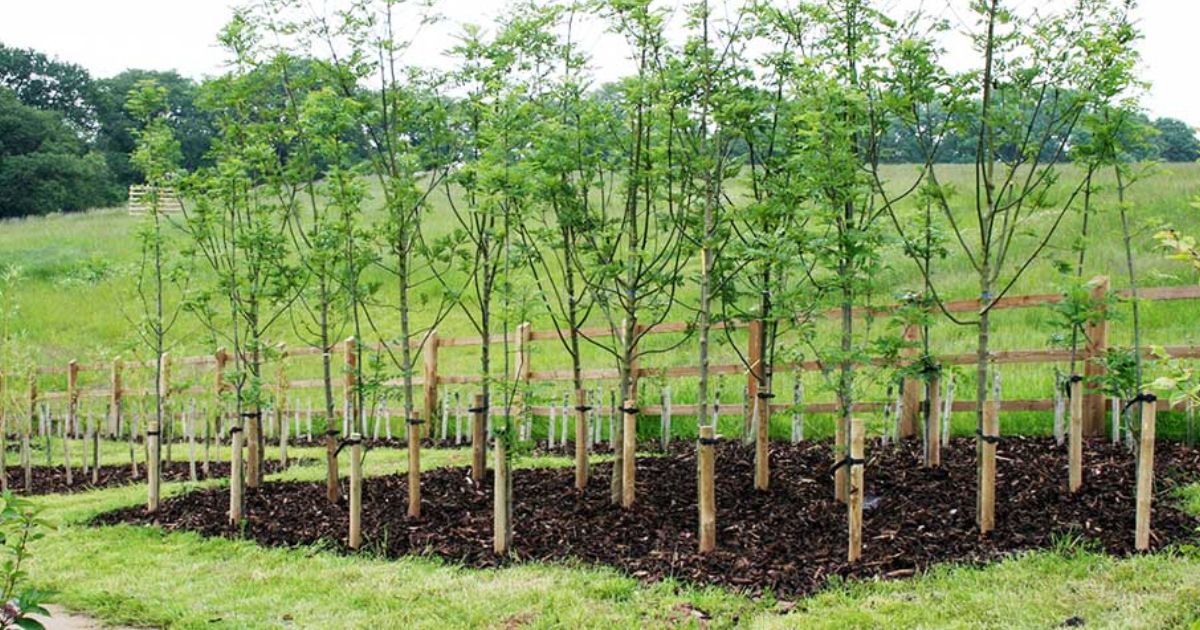
Uneven Sunlight (Phototropism): Trees naturally grow toward light. If one side receives significantly more sunlight than the other, the tree may lean in that direction over time.
A leaning tree, if not corrected, can develop a permanently crooked trunk, which may weaken its structure and affect its long-term health. Staking the tree properly helps provide Stability while allowing the Trunk to strengthen naturally.
When to Stake a Tree
Not every leaning tree needs staking. In fact, many trees can correct themselves naturally if the lean is minor. Knowing when to stake a tree ensures you provide support only when necessary and avoid harming the tree’s development.
Newly Planted Trees: Young trees, especially those with smaller root systems, are most vulnerable to leaning. If the tree cannot stand upright on its own or is easily moved by the wind, staking is recommended.
Trees in Windy Areas: Trees planted in open spaces exposed to strong winds are more likely to lean or be uprooted. Staking helps anchor the tree until its roots become established.
Leaning After Planting: If a tree begins to lean immediately after planting, it may indicate improper placement or insufficient soil support. Staking can stabilise the tree while roots take hold.
Trees with Weak or Damaged Roots: Trees with shallow or damaged roots struggle to maintain upright growth. Staking provides temporary support while the root system recovers and strengthens.
Exceptions – When Not to Stake: Avoid staking mature trees or trees with minor leans that can self-correct. Over-staking can limit trunk movement, weakening the tree over time.
Tools and Materials You’ll Need
Before you start staking a leaning tree, gather the right tools and materials. Using proper equipment ensures the tree is supported safely without causing damage.
Stakes:
Stakes provide the main support for your tree. Choose stakes made of wood, bamboo, or metal, depending on your preference and the size of the tree. For small trees, a single stake may be enough, while larger or wind-exposed trees may require two or three stakes. Stakes should be strong enough to hold the tree upright but not so rigid that they prevent natural movement.
Soft Ties or Tree Straps:
Use flexible ties, soft straps, or specially designed ones. The tree is fastened to the stakes using tree ties. Avoid using wire, rope, or anything that can cut into the bark. Soft ties allow the tree to sway slightly, strengthening the Trunk while keeping it stable.
Hammer or Mallet:
A hammer or mallet is used to drive stakes into the ground. Ensure stakes are firmly set, but take care not to damage the roots or the soil around the tree.
Mulch (Optional):
Mulching the area around the tree’s base helps protect the roots, assists in retaining moisture, and gives the soil more Stability. Mulch should not be piled up against the Trunk, as this can cause decay.
Measuring Tools (Optional):
A measuring tape can help ensure stakes are positioned at the correct distance from the Trunk and that ties are placed at the right height, usually around 1/3 of the tree’s height.
Having these resources and instruments available before you start makes the staking process smoother and ensures your tree receives the best possible support.
Step-by-Step Guide to Staking a Leaning Tree
Properly staking a tree requires careful attention to detail. Follow these steps to correct a leaning tree safely while promoting healthy growth:
Assess the Lean
Before installing stakes, determine the direction and severity of the lean. Pruning Fig Trees for More Fruit: A Complete Guide Gently push the tree in the opposite direction to see how much support it needs. This helps you decide how many stakes to use and where to place them.
Choose the Right Stakes
Select stakes that are strong enough to support the tree without breaking. For small trees, one or two stakes are usually sufficient. For larger or wind-exposed trees, use three evenly spaced stakes to provide balanced support.
Drive Stakes into the Ground

Place the stakes outside the root ball, about 6–12 inches away from the Trunk, so they do not damage roots. Drive them deep enough to be stable, but leave some stake above ground for tying the tree. Stakes should not be positioned too near the TrunkTrunk. This can restrict root growth.
Attach the Ties
Use soft ties, tree straps, or flexible rope to secure the tree to the stakes. Tie loosely enough to allow slight movement, which encourages the TrunkTrunk to strengthen naturally. Position the ties at about 1/3 of the tree’s height from the ground.
Adjust the Tree
Gently straighten the tree to its natural upright position before tightening the ties. Avoid forcing the tree too quickly, as this can damage the Trunk or roots.
Check Stability
Once staked, gently shake the tree to ensure it moves slightly but remains stable. The tree should sway somewhat in the wind, which helps it develop a strong trunk and root system.
Monitor and Adjust
Regularly check the ties for rubbing, loosening, or cutting into the bark. Adjust the stakes and ties as the tree grows to prevent damage and ensure continued support.
Tips for Proper Tree Staking
Staking a tree may seem simple, but doing it incorrectly can harm the tree rather than help it. How to Make a Christmas Tree Last Longer Here are some essential tips to ensure your leaning tree grows strong and healthy:
Don’t Stake Too Tightly
Avoid fastening the tree to the stakes too tightly. The TrunkTrunk needs slight movement to develop strength. Overly tight ties can prevent natural sway, leading to a weak trunk.
Use Flexible, Soft Ties
Always use soft straps, tree ties, or flexible rope instead of wire or rough materials. These reduce the risk of cutting into the bark or damaging the Trunk as the tree grows.
Check Regularly
Inspect your staked tree frequently. Look for signs of rubbing, girdling, or loosening ties. Adjust ties as needed to accommodate growth and prevent injury.
Avoid Over-Staking
Use only as many stakes as necessary. Too many stakes can restrict trunk movement and reduce the tree’s natural ability to develop a strong structure.
Remove Stakes at the Right Time
Stakes are temporary supports. Remove them after one to two growing seasons, 5 Tips for Get Rid of Tree Suckers Easily or once the tree can stand upright on its own. Leaving stakes on too long can hinder natural growth.
Consider Soil and Root Health
Ensure the soil around the tree is firm but not compacted. Healthy roots are crucial for the tree to stand independently. Avoid excessively disturbing the root area when staking.
Position Stakes Correctly
Place stakes outside the root zone and at an appropriate distance from the Trunk. This prevents root damage and gives the tree room to grow without obstruction.
By following these tips, you can provide your leaning tree with the support it needs while encouraging healthy Trunk and root development.
Aftercare for a Staked Tree
Staking a tree is just the first step in helping it grow straight and strong. Proper aftercare ensures the tree establishes healthy roots and a sturdy trunk while avoiding potential problems associated with staking.
Watering
Newly staked trees need consistent watering to help their roots establish. Water deeply at the base of the tree 2–3 times per week, depending on rainfall and soil type. Avoid overwatering, as waterlogged soil can weaken roots and cause leaning or disease.
Monitor the Ties
Regularly inspect the knots to make sure they are not rubbing against the bark or becoming too tight. Adjust or loosen them as the tree grows. Soft, flexible ties help prevent damage while still providing necessary support.
Check for Pests and Disease
A stressed or leaning tree can be more susceptible to pests and diseases. Keep an eye out for unusual leaf discolouration, bark holes, or insect activity, and take action promptly if needed.
Encourage Natural Growth
While the tree is staked, allow the Trunk to move slightly. How to Cut a Tree Back Safely and Effectively Gentle swaying strengthens the Trunk and helps the tree develop a stable structure. Avoid forcing the tree upright beyond its natural position.
Remove Stakes on Time
Once the tree has developed a strong root system and can stand upright independently (usually after 1–2 growing seasons), remove the stakes. Leaving stakes on too long can cause the TrunkTrunk to weaken and limit growth.
Proper aftercare ensures that your staked tree not only stands upright but also grows healthy and resilient for years to come.
Common Mistakes to Avoid
Staking a tree incorrectly can do more harm than good. Avoid these common mistakes to ensure your leaning tree grows strong and healthy:
Over-Staking
Using too many stakes or tying the tree too tightly can prevent natural trunk movement. How to Stake a Tree That Is Leaning: Step by Step Guide Trees need slight swaying to develop strong trunks and roots. Over-staking can result in a weak, dependent tree.
Leaving Stakes On Too Long
Stakes are temporary supports. Leaving them on for more than 1–2 growing seasons can hinder the tree’s natural development and even cause the Trunk to become weak or deformed.
Placing Stakes Too Close to the Trunk
Driving stakes too close to the Trunk can damage roots and limit growth. Place stakes outside the root zone, typically 6–12 inches away from the Trunk.
Ignoring Soil and Root Health
Failing to check soil stability or watering needs can lead to further leaning or root issues. Even a well-staked tree can fail if the soil is weak, compacted, or waterlogged.
Straightening the Tree Too Aggressively
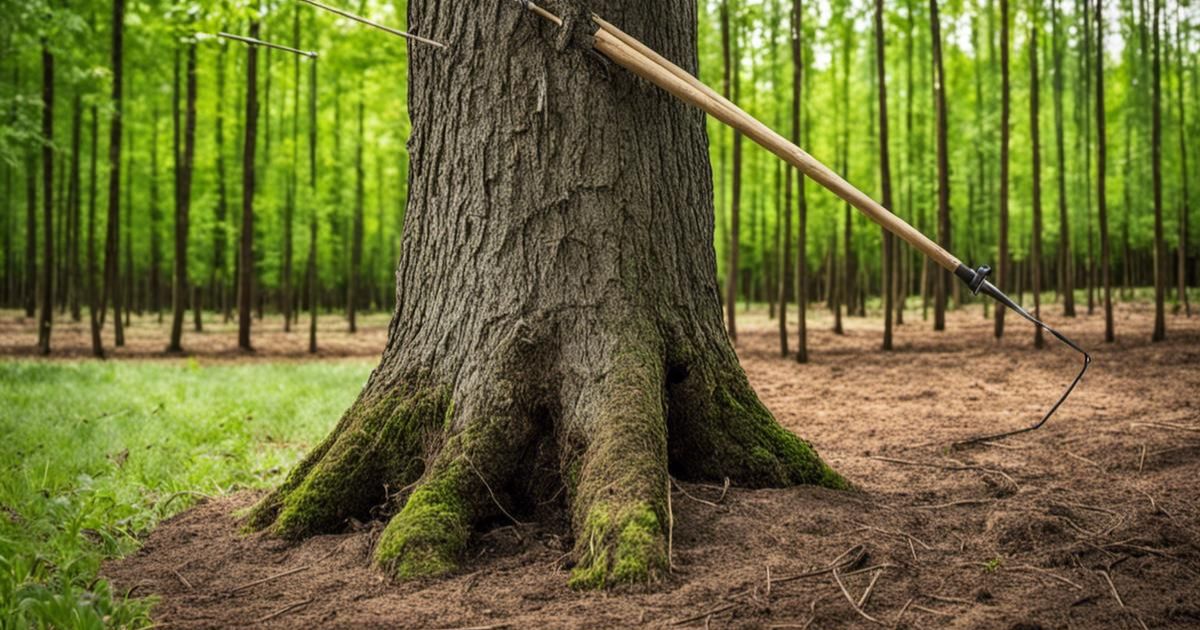
Forcing a tree into an upright position too quickly can break roots or damage the Trunk. Always straighten gently and allow the tree to adjust gradually.
By avoiding these errors, you can ensure your leaning tree receives proper support tree staking without compromising its long-term growth and health.
Conclusion
A leaning tree doesn’t have to be a lost cause. With the right approach to staking, you can help your tree grow upright, develop a strong trunk, and establish a healthy root system. The key is to assess the tree carefully, use proper tools and materials, and follow correct staking techniques.Remember to monitor the tree regularly, adjust ties as needed, and provide proper aftercare, including watering, mulching, and pest and disease checks. Avoid common mistakes such as over-staking, using inappropriate materials, or leaving stakes on too long. By providing your tree with temporary yet adequate support, you’re setting it up for years of healthy growth.
A well-staked and cared-for tree not only makes your yard more attractive but also guarantees its longevity and resilience against wind, weather, and other challenges. With patience and attention, even a leaning tree can thrive and stand tall.
FAQ
How long should I stake a leaning tree?
Most trees only need staking for 1–2 growing seasons. Once the roots are established and the tree can stand upright on its own, remove the stakes to allow natural trunk movement and strength development.
Can I stake a mature or large tree?
Staking is generally only necessary for young or newly planted trees. Mature trees usually have well-established root systems and can naturally correct minor leans. For large trees with severe leaning, consult an arborist before attempting to stake.
What materials are safe for staking a tree?
Use soft, flexible ties such as tree straps, silky rope, or commercial tree ties. Avoid wire, string, or anything that can cut into the bark. Stakes can be wood, bamboo, or metal, depending on the size of the tree.
How do I know if my tree needs staking?
A tree should be staked if it cannot stand upright on its own, leans significantly after planting, or is exposed to strong winds that could uproot it. Minor leans in healthy young trees may correct naturally without staking.
Can staking damage a tree?
Yes, improper staking can harm a tree. Over-staking, tying too tightly, using rough materials, or leaving stakes on too long can weaken the Trunk, damage roots, and limit growth. Always follow proper staking techniques.

